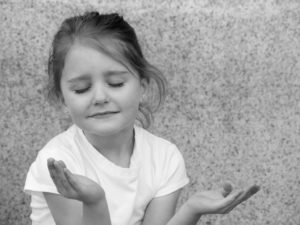REsources for Living
November 1, 2016Podcast: Download (Duration: 4:51 — 4.5MB)
Subscribe: More
 I didn’t learn a whole lot about prayer growing up in a UU church in the 60s and 70s. It just wasn’t something you did in a humanist congregation—either with the adults in the service or with other kids in religious education. So what I knew about praying came from pretty scattered sources.
I didn’t learn a whole lot about prayer growing up in a UU church in the 60s and 70s. It just wasn’t something you did in a humanist congregation—either with the adults in the service or with other kids in religious education. So what I knew about praying came from pretty scattered sources.
There were the prayers we said in Hebrew when we lit the Chanukah candles or celebrated the Passover Seder. Those were the same words every time, in a language that was utterly foreign to me. It was cool, like a magic spell: Baruch ata adonai, eloheinu melech ha’olam…. And there was a kind of magic in the candles that we lit, the bitter herbs we ate, the juice (wine for the adults) that we drank.
But those words, which start every Jewish blessing, were also something of a puzzle when we said them in English. Praised be you, oh Lord our God, King of the Universe…. Who was this God, King of the Universe, who commanded us to light candles, who was the creator of the fruit of the vine?
Well, the other place where that God, and the notion of praying, showed up was in the books of Louisa May Alcott, who wrote Little Women and a bunch of other books I loved. The little women of the Alcott books prayed, as did their parents. They turned to God when they were lonely, or when they were trying to be good under hard circumstances. This God seemed a lot like their Marmee and Papa: kind and loving and trustworthy, but with very high standards.
I only learned as an adult that Alcott was herself a Unitarian, and that Papa in the books was modeled on her own father, Bronson Alcott. Bronson was part of the Transcendentalist circle that included Emerson and Thoreau, and these Transcendentalists believed in a God who could be found not just in the Bible, but also in nature, and in the quiet of your own heart.
Was this loving parent God of the little women the same as the King of the Universe God of the Hebrew prayers? Hard to say. I really didn’t know how to go about praying in the way that Jo and her sisters seemed to do so naturally, and the incantations of the Hebrew prayers were something that my family only brought out for special occasions.
I learned a little bit more about prayer as I went along. I went to school in England for three months when I was nine, and every day started with an assembly at which we said the Lord’s Prayer. Memorizing the central prayer of Christianity has turned out to be useful in a number of situations in my life as a minister, but saying it every morning with my schoolmates was really not much different than the experience of saying the Pledge of Allegiance back in the United States. It was just some words that you said to start the day.
I did take a class in prayer when I was in seminary in Berkeley, studying to be a minister. The woman who taught the class was a delightful UCC minister who would close out every class with a good 10-15 minutes of prayer. First she would dim the lights in the classroom and invite us to get comfortable, and then she would begin to pray in a soothing voice. And in spite of my best intentions, every single time our period of prayer turned into my period of napping.
So most of what I know about praying I’ve picked up on the job in the course of my life as a minister. Here’s some of what I know:
- It’s fine to pray with a set of words you repeat every time, and it’s fine to say a prayer that is whatever is in your heart at the moment. The set words give a sense of ritual and stability, and connect us with others who might be saying those same words. The prayer that comes out of your heart in the moment is your personal connection to the Holy, and a beautiful thing.
- You don’t have to have a particular name or image for the Holy in order to want to connect to it.
- There is never a bad time to be grateful. It’s good to say thank you to the people who do nice things for you, but most of what we enjoy in life comes from a source far beyond the people we know personally. Saying thank you for sunsets and breezy mornings and giant trees and hummingbirds and the smell of cut grass is a good thing. We are better human beings when we remember that life is a gift.
- Praying is what you can do when there is nothing you can do. When people are gravely ill or suffering you can pray for them. When your life feels out of control or you don’t know how to make a difficult decision, you can pray. Praying is a way to find a place of openness when things feel like they’re closing in.
After all this time, the best description I have of what prayer is, and how you do it, is simply this: Prayer is opening a door in your heart, so that love can go both out and in.
- REsources for Living - December 1, 2020
- A Fond Goodbye - December 1, 2020
- REsources for Living - November 1, 2020
Comments are closed.
Renew Your Membership
We invite you to join your fellow CLFers to renew your CLF membership and stewardship of the CLF for another year.
Support the CLF
Can you give $5 or more to sustain the ministries of the Church of the Larger Fellowship?
Newsletter Signup
About
Quest for Meaning is a program of the Church of the Larger Fellowship (CLF).
As a Unitarian Universalist congregation with no geographical boundary, the CLF creates global spiritual community, rooted in profound love, which cultivates wonder, imagination, and the courage to act.
Contact
Church of the Larger Fellowship Unitarian Universalist (CLFUU)
24 Farnsworth Street
Boston MA 02210


Just listened to this then went to Google and found it reflecting Little Women in honor of LMA’s 184th birthday.